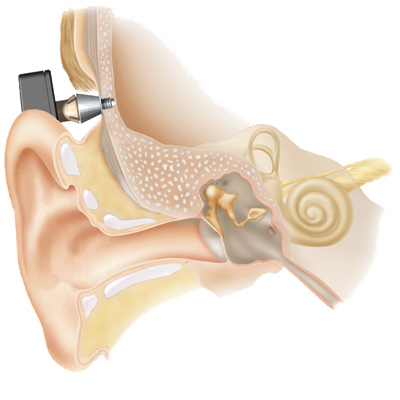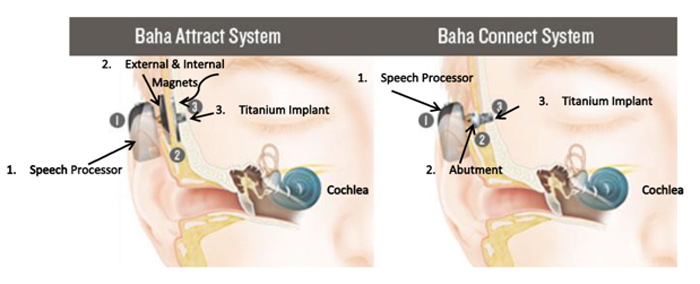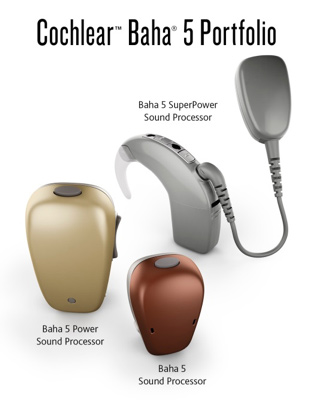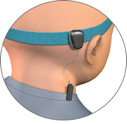Hearing Solutions and Treatments Overview
Our team offers tailored hearing solutions encompassing the full range of hearing technologies. There is no such thing as a one-size-fits-all solution to hearing loss. We understand that people’s lives are different and so are their hearing needs.
Hearing Solutions Tailored for Your Needs
- Hearing aids are a common non-invasive treatment option for hearing loss. A hearing aid is a small electronic device worn in or behind the ear to amplify sounds. Hearing aids today create a clearer, sharper, more natural sound for the person wearing the device. Select the Hearing Aids tab to learn more.
- The Baha® System is a specialized bone conduction device that can be used by individuals with conductive hearing loss or unilateral hearing loss (single sided deafness). Select the The Baha® System tab to learn more.
- The Osia® System is an active bone conduction solution that uses a Piezo PowerTM transducer to send signals to the cochlea. It can be used for conductive hearing loss, mixed hearing loss and single-sided deafness (SSD).
- A cochlear implant is a specialized technology that allows individuals with severe to profound hearing loss to hear and understand sound. The cochlear implant electrically stimulates nerve cells in the inner ear, which send a signal up the hearing nerve to the brain. For more information, please visit the Cochlear Implant Center.
Meet with one of our audiologists for a free consultation to discuss your hearing needs.
19 Bradhurst Ave
Suite 3600S
Hawthorne, NY 10532
Phone: 914.693.7636
Fax: 914.207.0900
Hearing Aids
Hearing aid technology has made remarkable advances in recent decades. Commonly used as a minimally-invasive option for treating hearing loss, a hearing aid is a small electronic device placed in or behind the ear for sound amplification. Today’s modern hearing aids offer clear, sharp, more natural sounds for the wearer. Many hearing aids pair wirelessly with smartphones and other devices, giving the user more control over volume and environment. While hearing aids do not provide total hearing restoration, they make it much easier to hear and participate in conversation without working hard to “fill in the blanks.”
What Is a Hearing Aid?
There are three basic components to a hearing aid: a microphone, an amplifier and a speaker. The microphone picks up sound waves and converts them to electrical signals, which are intensified by the amplifier, and then transmitted to the ear via speaker. A small computer is also a component of digital hearing aids.
5 Styles of Hearing Aid
There are five basic styles of hearing aids that vary in size, placement and degree of amplification. Your WMCHealth Physicians audiologist can recommend the appropriate style based on your individual needs and the severity of your hearing loss.
- Behind the Ear (BTE): Available in Standard, Mini and Power. This is the most common hearing aid style. As the name suggests, these hearing aids are worn behind the ear; they are connected to a custom mold that is placed inside the ear canal. BTE hearing aids come in a variety of colors and have easy to use buttons and discreet designs. BTE hearing aids may be appropriate for individuals with mild to severe hearing loss.
-
Receiver-In-Canal (RIC): The most popular and cosmetic hearing solution available, these small and discreet hearing aids are also worn behind the ear, coupled to a thin receiver wire and small dome. This style also comes in a variety of colors and sizes, including standard, mini and power. These versatile hearing aids may also be Bluetooth compatible for our active clients.
-
In the Canal (ITC): These small custom hearing aids fit in the ear canal. They are perfect for many individuals with mild to moderate hearing loss, though not typically used for children since they will be quickly outgrown.
- Completely in the Canal (CIC) and Invisible in the Canal (IIC): The small and smallest hearing aids, CIC and IIC hearing aids are very appealing cosmetically because they are so tiny, no one will notice them! These devices are suitable for mild to moderately-severe hearing loss. As with ITC, these hearing aids are not typically used for children since they will be quickly outgrown.
Schedule a Free Hearing Aid Consultation
Congratulations on taking the first step to better hearing! Let our team of experts walk you through this process to make better hearing part of your life. Our friendly, knowledgeable team will provide you with the best recommendation based on your individual lifestyle and needs.
We are happy to discuss any and all questions in order to help make this process as stress-free as possible. Call 914.693.7636 for a free consultation.
Baha® System: Osseointegrated Temporal Bone System
What Is A Baha®?
The Baha® System is a specialized bone conduction device that can be used by individuals with conductive hearing loss, mixed hearing loss and those with unilateral profound hearing loss (single sided deafness). In the normal hearing ear, sound travels through the eardrum and three middle ear bones. Movement of these three bones provides stimulation of the cochlear (inner ear). Most hearing devices transmit sound via this air conduction mechanism. The Baha® transmits sound via bone conduction and provides direct stimulation of the cochlea.
Who Can Benefit From A Baha®?
Individuals with chronic middle ear conditions or middle or outer ear congenital anomalies who cannot use a conventional hearing aid are potential candidates for Baha®. This may include individuals with chronic middle ear drainage, individuals with external ear canal anomalies or individuals with conductive or mixed hearing loss who do not receive sufficient benefit from conventional air conduction hearing aids.
The Baha® may also be indicated for individuals with severe profound sensorineural hearing loss in one ear.
How Does The Baha® Work?
- A small titanium implant is placed in the bone behind the ear. Implantation requires a short outpatient procedure. After healing and allowing time for the implant to osseointegrate (attach firmly to the bone), the external component (sound processor) is attached.
- The external sound processor picks up sound vibrations and sends them to the internal implant in one of two ways:
- The Baha® Connect: The external processor snaps into a small abutment that sits on the skin and connects directly to the titanium implant. Sound vibrations from the processor are sent directly through the bone to the inner ear (cochlea), stimulating the inner hair cells (nerve cells) and eliciting a sensation of hearing.
- The Baha® Attract provides a magnetic connection between the implant and the external speech processor. During surgery, the implant is attached to a magnet that is placed under the scalp. Once activated, the speech processor is connected to an external magnet that sits on the scalp and communicates with the internal magnet. Sound is transmitted via these magnets to the implant and the inner ear is stimulated.

Who Is A Potential Candidate For A Baha®?
Individuals with single-sided deafness

The Baha® is indicated for individuals who have no usable hearing in one ear and normal or near-normal hearing in the other ear. The Baha® transmits sound from the poorer hearing ear to the better hearing ear to provide sound awareness and hearing from all sides.
Individuals with conductive or a mixed hearing loss
Individuals with at least a 30 dB HL conductive component and no worse than a moderate sensorineural loss may benefit from direct stimulation of the cochlea. Typically these are individuals who cannot wear or receive limited benefit from traditional air conduction hearing aids.
Three different speech processors accommodate various degrees of hearing loss. Candidacy for each device is based upon the degree of sensorineural hearing loss.
- Baha® 5: Bone conduction thresholds up to 45 dB HL
- Baha® 5 Power: Bone conduction thresholds up to 55 dB HL
- Baha® 5 Super Power: Bone conduction thresholds up to 65 dB HL
What Is A “Baby Baha®?”

Surgical placement of the titanium implant is only FDA-approved for children over the age of five years. Younger children wear the Baha® on a soft headband. The speech processor snaps into a plastic piece on the headband. This plastic piece transmits vibrations to the bone to elicit a response from the inner ear (cochlea). Children who derive benefit from the headband-worn Baha® can receive a surgically placed implant after their fifth birthday.
How Do I Know If I Am A Baha® Candidate?
Evaluation for Baha® is performed by a neurotologist and an audiologist.
- Neurotologist (ear surgeon subspecialist):
- The neurotologist performs a thorough case history and physical examination.
- In addition, the doctor orders radiologic studies, such as CT scan and/or MRI scan to evaluate the integrity of the outer, middle and inner ear and auditory nerve.
- If approved for the Baha®, the neurotologist performs the implant surgery and provides regular medical care for the implant long term.
- Audiologist:
- The audiologist performs a basic audiologic assessment to confirm your hearing levels.
- Testing is performed to measure your hearing levels and your ability to understand speech with a traditional hearing aid, if possible, and with a Baha® coupled to a headband.
Do I Need Any Other Listening Equipment?
Many individuals find that they can further improve their ability to understand spoken language by using other types of technology in conjunction with their Baha®. The Baha® can be ordered with other external devices:
- Direct iPhone Connectivity: The Baha® couples directly to an iPhone or iPad for direct audio streaming and cell phone conversations. The Baha® app allows you to use your iPhone as a remote control to adjust volume and programs and to locate your device if it is lost.
- MiniMic remote microphone: The MiniMic “streams” sound directly from another person or directly from an audio source (such as a TV or radio) to the Baha® processor. These devices improve the user’s ability to hear from a distance and/or to hear in noisy or reverberant environments.
- Phone Clip: Audio output from a Bluetooth enabled device, such as a cell phone or computer, can be directly streamed to your Baha® processor. This allows for hands-free talking on the phone and better speech understanding of electronic devices.
What Do I Do If I Am Interested In Learning More About A Baha® Option For Myself Or A Loved One?
Call 914.693.7636 and request a consultation for a Baha®. You will be scheduled for an appointment to meet with one of our neurotologists to discuss Baha® technology and testing.
Meet the Audiologists
Audiologists are medical professionals who specialize in the evaluation, diagnosis and treatment of hearing and balance disorders. They utilize technology, creative problem solving and social skills to help people with these disorders to better communicate and connect with the world around them.

Rivka Bornstein, AuD, CCC-A |

Gregg Goldhagen MS, F-AAA |

Jessica Hoffman, AuD, CCC-A |

Melanie Katz AuD, F-AAA, CCC-A |

Maureen McGee, MS, CCC-A |

Samantha Morgan, AuD, CCC-A, F-AAA |

Mindy Schmelzer, AuD, CCC-A |

Colette Wolff, AuD, CCC-A |
|